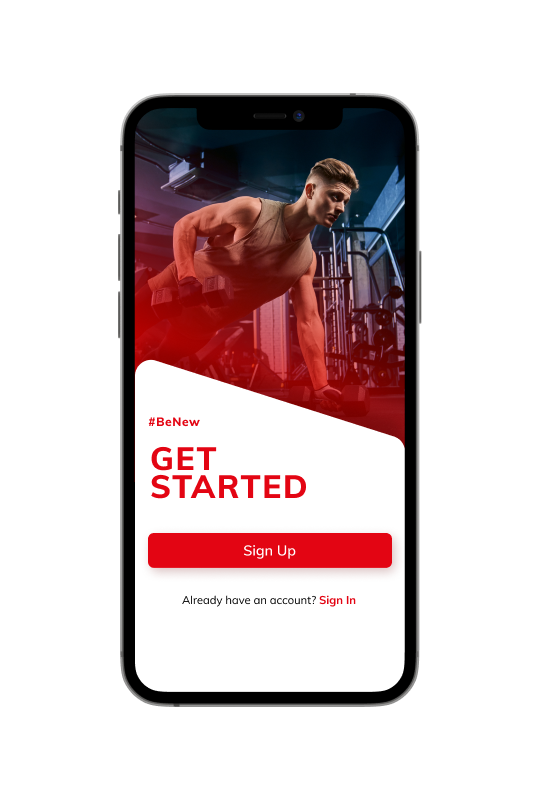The pursuit of fitness often feels like an endless struggle. Countless hours spent in the gym and endless dietary restrictions still leave many people without the desired physique or energy levels. Generic workout plans and one-size-fits-all nutrition advice simply don’t work. We’re bombarded with conflicting information, which leaves us confused and demotivated. The frustration of hitting a wall, getting injured, and not seeing progress is common, making the journey to optimal health challenging. This growing need has led to a boom in the fitness app industry, with users seeking digital platforms that offer specific guidance and support.
AI integration in fitness apps has transformed the industry by enabling highly personalized workout plans, nutrition advice, and real-time feedback. This is achieved through the use of advanced algorithms and machine learning, which analyze user data to create tailored fitness solutions. Apps like Freeletics show this technology’s potential, attracting millions of users worldwide. However, the demand for such intelligent fitness solutions far exceeds the current supply. With the global fitness app market expected to grow at a CAGR of 14.08% from 2024 to 2030, there is a substantial opportunity for you to create innovative and impactful solutions.
If you aspire to build an AI-powered fitness app like Freeletics, this guide provides a comprehensive roadmap. We’ll explore the core principles of AI-driven fitness, essential features, and functionalities and offer practical advice on development, budgeting, and monetization. By the end, you’ll have a solid understanding of the steps required to transform your fitness app idea into a thriving business.
Freeletics: Overview

Freeletics was developed by Freeletics GmbH and has been downloaded over 10 million times on the Google Play Store. It provides personalized high-intensity interval training (HIIT) and audio coaching using artificial intelligence. It creates custom workout plans based on your fitness level, goals, and preferences, ensuring effective exercise without the need for a gym.
The app combines fitness routines with mindfulness, which includes features like meditation and stress reduction exercises, and motivational strategies, such as goal setting and progress tracking, helping users build lasting, healthy habits and achieve long-term success. It also supports a strong community where users can connect, share experiences, and motivate each other.
Technically, Freeletics uses advanced algorithms and machine learning to analyze data and improve coaching over time. Features like progress tracking, nutritional advice, and interactive challenges make Freeletics a comprehensive and leading fitness solution.
What Makes The Freeletics App Unique?
Freeletics offers a wide range of features designed to meet various fitness goals and user needs. Here are some features that make it unique:
- Freeletics Bodyweight: Provides a series of bodyweight exercises that can be done anywhere.
- Freeletics Gym: Offers workout plans specifically for gym use and running plans customized to different fitness levels and objectives.
- Coach: An AI-powered coach that creates personalized workout plans based on user information.
- Training Journey: A structured program to help users progress through their fitness goals and keep track of user progress over time.
- Nutrition Plan: Offers customized meal plans and recipes and lets users monitor their food intake.
- Freeletics Challenge: Features timed challenges to encourage users.
- Freeletics Athletes: Showcases profiles of successful users to inspire others.
- Social Feed: Allows users to connect with friends, share achievements, and find motivation.
- Audio Coaching: Provides real-time audio instructions during workouts.
- In-app Purchases: Includes options for premium subscriptions and additional workout plans.
Why Do People Love Freeletics App?
Based on reviews, people love the Freeletics app for several reasons. Its AI-driven personalization creates custom workout plans based on individual fitness levels and goals. The app offers a range of workouts, from bodyweight exercises to gym routines and running plans, allowing for flexibility and convenience. Users value the ability to exercise anytime and anywhere without equipment. Additionally, Freeletics motivates users through community challenges and social feeds, while its progress tracking and personalized nutrition plans support comprehensive fitness goals. This blend of personalized workouts, varied options, and strong support makes Freeletics a top choice for fitness enthusiasts.
Market Analysis Of Freeletics And Other Fitness Apps
Here are some recent statistics that we have gathered to show you the potential we are talking about:
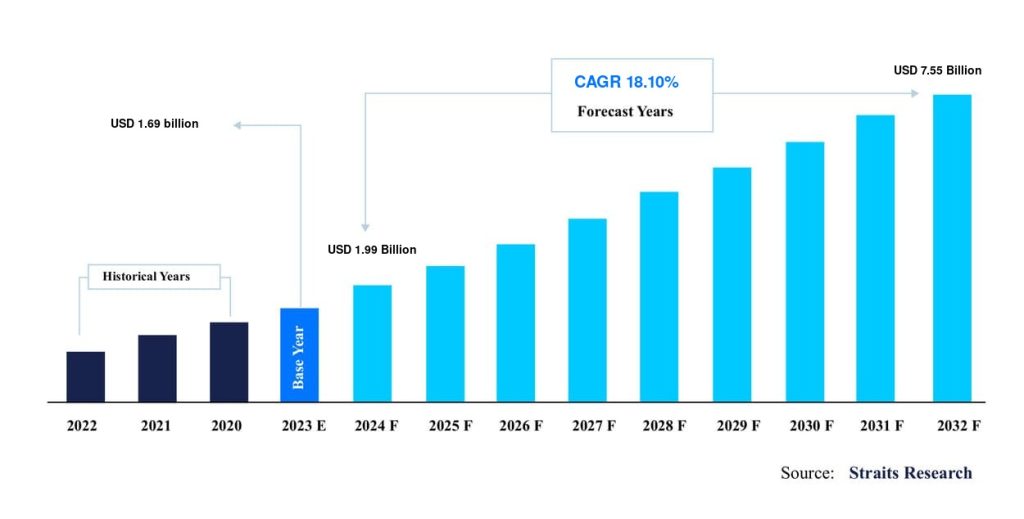
In 2023, the global fitness app market was valued at $1.69 billion. It is expected to grow significantly, reaching $7.55 billion by 2032, with a compound annual growth rate (CAGR) of 18.10% from 2024 to 2032. The United States holds the position as the largest market for fitness mobile applications globally.
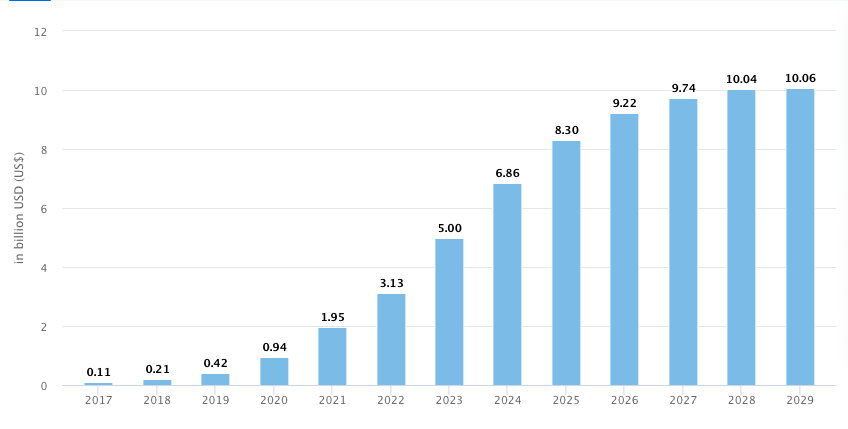
For 2024, total revenue in the fitness app sector is projected to hit $6.86 billion. In July 2024 alone, the Freeletics app generated $900,000 in revenue. Additionally, Freeletics reports having around 57 million active users worldwide.
These figures highlight the robust growth in the fitness app market, suggesting that launching a fitness app similar to Freeletics could be a lucrative opportunity for you if you are aiming to make an impact in the fitness industry.
Understanding The Business Model Of Freeletics
Freeletics utilizes a distinctive business model. Here are the effective ways it generates its revenue:
1. Freemium Model
Freeletics uses a freemium approach, allowing users to download the app and access basic features at no cost. This model provides an entry point for new users by offering fundamental workouts and features for free. It helps attract a large user base and promotes initial engagement with the app.
2. Premium Subscriptions
To access advanced features and personalized coaching, users can subscribe to premium plans. These subscriptions provide additional benefits, such as customized workout plans, exclusive content, and enhanced support. Offering multiple subscription tiers helps increase user engagement and generates ongoing revenue.
3. In-App Purchases
Freeletics also generates revenue through in-app purchases. Users have the option to buy extra workout plans, special challenges, and additional content within the app. This model allows users to enhance their fitness experience and provides additional revenue opportunities.
4. Corporate Fitness Programs
Freeletics offers corporate subscriptions, providing companies with fitness solutions for their employees. These programs often include bulk pricing and customized plans tailored to organizational needs. Corporate subscriptions help expand the app’s market reach and offer another revenue channel.
What Features Make Freeletics App Popular Among Its Users?
Freeletics has become popular for several notable features that meet various fitness needs:
1. AI-Powered Personal Coach
The AI-driven Coach creates customized workout plans based on individual fitness levels and goals. This ensures that each workout is suited to the user’s needs and adapts as they progress while keeping the experience effective and engaging.
2. Bodyweight Training
Freeletics focuses on bodyweight exercises, which require no special equipment. This makes it easy for users to work out anywhere, whether at home or while traveling. This feature provides flexibility and convenience.
3. Gym-Based Workout Plans
For those who prefer using gym equipment, Freeletics offers specific plans for gym workouts. These plans are designed to make the most of available equipment while accommodating different fitness settings.
4. Running Programs
The app features running plans that cater to all levels, from beginners to advanced runners. These structured programs help users improve their endurance and speed, making it a suitable choice for runners at any stage.
5. Personalized Nutrition Guidance
Freeletics offers personalized meal plans and tracking that align with users’ fitness goals. This integration of diet and exercise supports improved results and helps users stay on track with their health objectives.
6. Motivational Challenges
The app includes ‘challenges’ that offer rewards for completing fitness goals within a set timeframe. These competitions help users stay motivated and add a fun and competitive element to their workouts.
7. Community And Social Features
Freeletics builds a community with features like a ‘social feed’ and ‘athlete profiles.’ Users can connect with others, share their achievements, and find inspiration from other members while creating a supportive and motivating environment.
Innovative Features That Can Enhance An AI Fitness App Like Freeletics
Here are some innovative features that could elevate an AI fitness app beyond the current standards:
1. Real-Time Biometrics For Hyper-Personalized Workouts
Incorporate advanced sensors to track real-time biometrics such as heart rate, muscle activation, and oxygen levels. By analyzing these metrics during workouts, the app can adjust exercises instantly to match the user’s current physical state, ensuring optimal performance and safety.
2. AR VR For Immersive Home Workouts
Introduce AR to create interactive workout environments. By overlaying digital elements in the real world, AR can make home workouts more engaging and effective. Users can follow virtual trainers and receive real-time feedback, while VR can offer entirely virtual training spaces, making workouts more engaging and interactive.
3. Advanced Injury Prevention
Integrate biometric sensors and data-driven tools to monitor physical stress and detect early signs of potential injuries. The app can then suggest preventive exercises and modifications to reduce injury risk and improve overall safety during workouts.
4. Sleep Analysis Integration
Combine sleep tracking with workout performance data to offer insights into how sleep patterns affect fitness and recovery. This holistic approach can help users optimize their routines for better results and overall health.
5. AI-Powered Workout Buddies
Match users with virtual workout partners who have similar fitness goals and preferences. This feature fosters a sense of community and accountability, making workouts more enjoyable and socially engaging.
How To Develop An AI-based Fitness App Like Freeletics?
Here are the developmental steps to create an AI-based fitness app like Freeletics:
1. Deep Dive Into Human Physiology And Psychology:
Unlike generic fitness apps, Freeletics excels in understanding the human body and mind. So, to create a compelling fitness app, start with a thorough understanding of exercise science and human psychology. This involves researching how different exercises impact the body and mind. By integrating this knowledge, you can design workout routines that not only enhance physical fitness but also engage users mentally, keeping them motivated throughout their fitness journey.
2. AI Algorithm Development For Hyper-Personalization:
The key aspect of an AI-based fitness app is its ability to deliver personalized experiences. So, focus on developing AI algorithms that go beyond basic personalization and are capable of analyzing various user metrics—such as metabolism, recovery rates, and progress—to customize workout plans specifically for each user. This means creating algorithms that adapt over time, using machine learning to refine recommendations based on user interactions and data.
3. Comprehensive Data Collection And Analysis:
Incorporate wearable technology to gather real-time biometric data, such as heart rate, muscle activity, and stress levels. This data enables the app to make immediate adjustments to workout plans and ensure that they are effective and aligned with users’ current states. Additionally, make sure to collect comprehensive data, including user fitness levels and preferences, and progress so you build a more dynamic and responsive fitness experience for your users.
4. Personalized Nutrition And Supplement Optimization:
Extend the capabilities of your app to offer customized nutrition advice and supplement recommendations. You can personalize meal plans and supplement suggestions based on individual fitness goals, dietary restrictions, and workout routines. Moreover, you can create workout plans that dynamically adjust based on real-time data and user feedback. This approach will ensure that your users receive a balanced plan that supports their fitness objectives from multiple angles.
5. Injury Prevention And Rehabilitation Tools:
Integrate AI-powered features to assess and mitigate injury risks. Develop tools that provide preventive exercises and personalized rehabilitation plans to support users through injury recovery and avoid future issues. This addition makes the app a comprehensive tool not only for fitness but also for injury management.
6. Mental Health Integration:
Recognize that fitness is closely linked to mental well-being and go beyond physical fitness by incorporating mental health features. Incorporate features such as mood tracking, stress management techniques, and mindfulness exercises. By addressing mental health, your app can offer a more complete solution to users’ overall wellness needs and will make it more appealing to a broader audience.
7. Augmented Reality (AR) And Virtual Reality (VR) Workouts:
AR/VR can significantly enhance your fitness app by providing immersive workout experiences. AR can overlay digital information onto the real world while guiding users through exercises with visual cues. On the other hand, VR can offer fully immersive environments for virtual coaching and workouts. These technologies make workouts more engaging and enjoyable and offer users a novel way to interact with their fitness routines.
8. Gamification And Social Interaction:
To boost user engagement, incorporate gamification elements such as challenges, badges, and leaderboards. These features create a competitive and rewarding environment that keeps users motivated. Additionally, develop robust social features that allow users to connect with others, share their progress, and support each other while building a sense of community and competition.
9. Advanced Analytics And Continuous Improvement:
Utilize advanced analytics to predict user behavior and offer proactive recommendations for personalized fitness guidance. Coupled with detailed performance tracking, this approach offers valuable insights into user progress and identifies areas needing improvement. To continuously enhance the app, regularly gather and analyze user feedback, making necessary adjustments. Additionally, keep the app engaging with ongoing updates that introduce new features, workouts, and content based on evolving user needs and preferences.
Tech Stack For Freeletics Clone App Development
While the core tech stack for a fitness app is relatively standard, creating an AI-driven app like Freeletics requires specific technologies to handle complex algorithms, data processing, and user experience. Here are some unique tech stacks specifically chosen for such an app:
| Category | Tech Stack |
| AI and Machine Learning | TensorFlow, PyTorch, Keras, scikit-learn |
| Data Collection and Processing | Apache Kafka, Apache Spark, Hadoop |
| NLP | NLTK or spaCy |
| Backend Development | Node.js, Django, Flask, GraphQL |
| Frontend Development | React Native, Redux, Three.js |
| Computer Vision | OpenCV |
| Cloud Services and Infrastructure | AWS, Google Cloud Platform, Firebase, Kubernetes |
| Biometric and Wearable Integration | Apple HealthKit, Google Fit, Bluetooth Low Energy (BLE), Wearable device SDKs |
| Augmented Reality (AR) and Virtual Reality (VR) | ARKit, ARCore, Unity, Unreal Engine |
| Analytics and Monitoring | Google Analytics, Mixpanel, Prometheus, Grafana |
| Additional Consideration | Edge Computing, Federated Learning, Explainable AI |
How To Generate Revenue From A Fitness App Like Freeletics?
When developing a fitness app, understanding how to generate revenue is crucial for its success. Here are some effective strategies that can help you monetize your fitness app effectively:
- Implement a freemium approach by offering a basic version of your fitness app for free and, to drive revenue, offer premium options with advanced features, personalized coaching, and exclusive content.
- Add in-app purchases for additional workout plans, challenges, or exclusive content. This allows users to enhance their experience and creates additional revenue streams.
- Create subscription plans, such as monthly, quarterly, or annual options. Provide subscribers with advanced features, personalized support, and exclusive content. This model ensures consistent revenue and promotes user retention.
- Build partnerships with businesses to offer customized corporate fitness programs. These programs can include group discounts and customized plans for companies invested in employee wellness.
- You can also earn revenue through ads and sponsored content. Work with brands to display relevant ads or sponsor app features, but make sure that the ads are relevant and minimally disruptive.
- Promote fitness products, supplements, or equipment through affiliate marketing. Partner with brands to feature their products and earn commissions on sales.
- Introduce branded merchandise such as workout apparel and gear. This not only provides extra revenue but also strengthens brand visibility and recognition.
- Collaborate with insurance companies to offer discounted premiums for users meeting fitness goals. This motivates users and creates another revenue source.
Challenges In Developing An AI-based Fitness App Like Freeletics
Creating an AI-powered fitness app similar to Freeletics presents several significant challenges:
- User Data Protection: Implement advanced encryption techniques and secure authentication to safeguard user information.
- Regulatory Compliance: Adhere to data protection regulations such as GDPR and CCPA, requiring detailed planning and legal oversight.
- Algorithm Accuracy: Develop precise algorithms for personalized workout recommendations and real-time feedback.
- Data Processing: Collect and process extensive datasets to effectively train AI models, which can be resource-intensive.
- Continuous Improvement: Regularly update AI systems to adapt to user progress and preferences.
- Motivation Strategies: Integrate interactive features, gamification, and community elements to maintain long-term user interest.
- Scalability: Build infrastructure capable of handling increasing user numbers and real-time data processing.
- Integration: Connect with various fitness devices and third-party services for comprehensive tracking and insights.
- Differentiation: Offer unique features and strong value propositions to stand out in a crowded market.
- Effective Marketing: Develop strategies to attract and retain users amidst competitive pressures.
Cost of Developing An AI-Based Fitness App Like Freeletics
Creating an AI-based fitness app similar to Freeletics involves various costs depending on the app’s features, complexity, and development process. Here’s a detailed breakdown of the key cost components:
| Cost Component | Description | Estimated Cost |
| Concept and Design | Market research, competitor analysis, defining app features, wireframes, prototypes, and user testing to ensure a user-friendly design. | $2,000 – $8,500 |
| Frontend Development | Coding the user interface and integrating visual elements. | $1,000 – $13,000 |
| Backend Development | Server-side components, databases, and AI algorithms. | $2,000 – $16,000 |
| AI and Machine Learning Integration | Implementing AI for personalized recommendations and analytics. | $3000 – $22,000 |
| Testing and Quality Assurance | Ensuring all features work as intended across devices and OS and evaluating app performance and data protection measures. | $800 – $6000 |
| Deployment and Launch | Submission fees for platforms like Apple App Store and Google Play Store, along with initial marketing campaigns, social media promotions, and other launch activities. | $800 – $6000 |
| Ongoing Maintenance | Bug fixes, updates, server costs, and regular maintenance. | $200 – $3,500 per year |
| Feature Enhancements | Adding new features and improvements based on user feedback. | $700 – $10,000 per year |
| Total Estimated Cost | $10,500 – $85,000 |
Factors That Affect The Cost Of Freeletics Clone App Development
The total cost of creating a Freeletics clone app is influenced by several factors:
- Features: The inclusion of fundamental functionalities like personalized workout plans, as well as more sophisticated features such as nutrition tracking, affects the overall cost.
- Design: The intricacy and quality of UI/UX design, including bespoke graphics, play a significant role in determining expenses.
- Platform: Developing for both iOS and Android or opting for cross-platform solutions like React Native impacts the budget.
- Technology Stack: The use of cutting-edge technologies and AI frameworks can drive up costs.
- Testing: Expenses increase with comprehensive testing for functionality, usability, and performance.
- Maintenance: Ongoing updates and bug fixes contribute to long-term financial commitments.
- Development Team Location: The cost can vary depending on whether the development team is based locally or offshore.
- Marketing: Costs for app store optimization and promotional efforts also affect the total budget.
Top 5 Alternatives To The Freeletics App
When exploring alternatives to the Freeletics app, several options stand out, each offering unique features and specializations. Here’s a detailed look at five noteworthy alternatives that cater to different fitness needs and preferences:
1. Fitbod
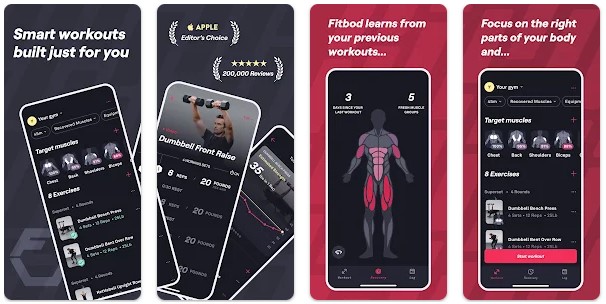
Fitbod specializes in creating customized workout plans based on the equipment you have and your fitness goals. It adjusts routines according to your progress to keep your workouts effective.
Key Features:
- Equipment-Based Workouts: Adapt exercises to the equipment available, whether at home or the gym.
- Progressive Overload: Ensures continuous improvement by gradually increasing workout intensity.
- Varied Exercise Options: Includes a wide range of exercises, from bodyweight to gym and outdoor workouts.
Ideal For: Individuals who want a personalized workout plan tailored to their available equipment and fitness objectives.
2. Evolve AI
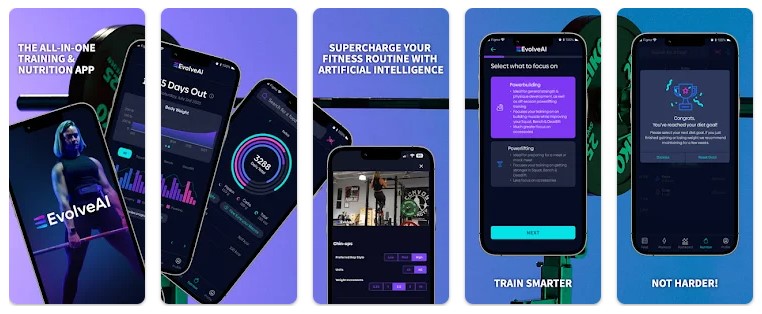
Evolve AI uses artificial intelligence to provide a comprehensive fitness experience. It combines personalized workouts with detailed nutrition and recovery plans.
Key Features:
- AI-Driven Coaching: Offers real-time adjustments and recommendations based on user data.
- Performance Insights: Provides detailed analytics on workout effectiveness and progress.
- Recovery Suggestions: Includes recovery tips and wellness advice based on performance.
Ideal For: Users who seek a data-driven approach to fitness that integrates exercise with nutrition and recovery guidance.
3. Aaptiv
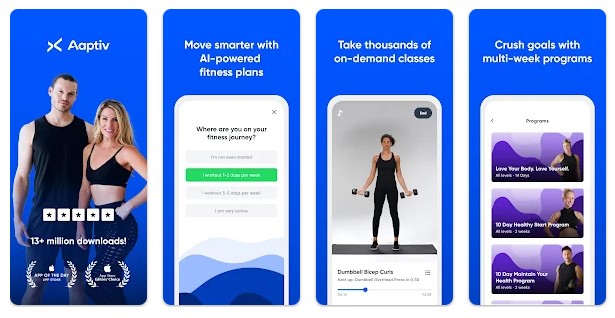
Aaptiv focuses on audio-guided workouts led by professional trainers. The app features a variety of workout types to accommodate different fitness levels and preferences.
Key Features:
- Audio Instructions: Provides guidance through audio, making it easy to follow workouts without visual aids.
- Diverse Workouts: Offers a range of activities, including running, strength training, and yoga.
- Experienced Trainers: Access to trainers who specialize in different workout styles and techniques.
Ideal For: Those who prefer audio instructions and a variety of workout formats that can be followed without needing to view screens.
4. Dr. Muscle
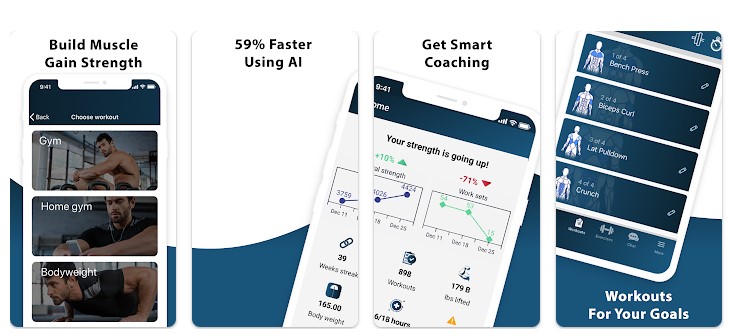
Dr. Muscle targets muscle building and strength training with AI-enhanced workout plans. It offers detailed exercise instructions, and tracks progress to optimize results.
Key Features:
- AI-Powered Workouts: Customizes routines for muscle growth and strength enhancement.
- Detailed Exercise Guides: Includes clear demonstrations to ensure proper technique.
- Progress Monitoring: Tracks and adjusts workouts based on your progress.
Ideal For: Weightlifters and bodybuilders looking for strength-focused routines with advanced tracking.
5. MyFitnessPal

MyFitnessPal is a leading app for tracking calories and nutrition. It complements fitness routines with an extensive food database and integration with fitness devices.
Key Features:
- Extensive Food Database: Provides access to a wide range of food items for accurate calorie counting.
- Integration with Fitness Devices: Syncs with other apps and devices for a complete health overview.
- Personalized Nutrition Plans: Offers personalized diet plans to help achieve fitness goals.
Ideal For: Individuals focused on managing their diet and tracking their calorie intake while integrating nutrition with their fitness routines.
Conclusion
Developing an AI-based fitness app like Freeletics presents a promising opportunity to innovate in the wellness sector. By integrating advanced AI algorithms and ML techniques, you can create an app that offers personalized fitness plans, adapts to user progress, and provides real-time feedback. This approach not only enhances user engagement but also ensures that fitness routines are aligned with individual goals. With careful planning and the right technology stack, your AI-based fitness app can stand out in the market, offering users a unique and effective tool for achieving their fitness objectives.
Develop A Freeletics Like App With Idea Usher
Collaborate with Idea Usher to build a top-tier fitness app akin to Freeletics. Our team excels in developing AI-powered fitness solutions that offer customized workout plans aligned with each user’s objectives and progress. We emphasize using machine learning to improve user experience, deliver instant feedback, and track progress comprehensively. With our development skills, we guarantee a smooth, user-friendly design and seamless integration with wearable devices. Partner with Idea Usher for innovative and high-quality app solutions that make a mark in the competitive fitness app industry. Reach out to us today!
Work with Ex-MAANG developers to build next-gen apps schedule your consultation now
FAQ
How is AI used in fitness apps?
AI in fitness apps enhances user experience by personalizing workout routines and nutrition plans based on individual data. It analyzes user progress, predicts future needs, and provides tailored recommendations. AI-driven apps can also offer virtual coaching and adjust plans in real-time to optimize fitness results and engagement.
How can I create my own fitness app?
To create your own fitness app, start by defining its purpose and target audience. Develop a user-friendly design and include features such as workout tracking and personalized plans. Choose a technology stack, either build it from scratch or use app development platforms. Ensure thorough testing and launch with marketing strategies to attract users.
How profitable are fitness apps?
Fitness apps can be highly profitable, especially with a well-defined target market and effective monetization strategies. Revenue models include subscription fees, in-app purchases, premium features, and advertising. Popular apps often attract significant user bases, leading to substantial earnings. Profitability depends on app quality, user engagement, and effective marketing strategies.
How long does it take to develop a fitness app?
The development time for a fitness app varies depending on its complexity and features. On average, it can take 3 to 6 months to develop a basic app. More complex apps with advanced functionalities may take up to 12 months or longer. Timelines include design, development, testing, and deployment phases.




















